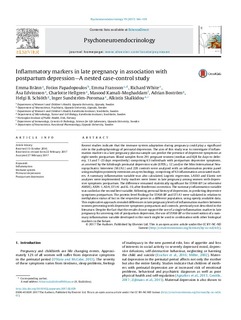Inflammatory markers in late pregnancy in association with postpartum depression-A nested case-control study
Bränn, Emma; Papadopoulos, Fotios; Fransson, Emma; White, Richard; Edvinsson, Åsa; Hellgren, Charlotte; Kamali-Moghaddam, Masood; Boström, Adrian; Schiöth, Helgi B.; Sundström-Poromaa, Inger; Skalkidou, Alkistis
Peer reviewed, Journal article
Published version
Permanent lenke
http://hdl.handle.net/11250/2457928Utgivelsesdato
2017Metadata
Vis full innførselSamlinger
- Artikler [5061]
- Publikasjoner fra CRIStin FHI [7536]
Sammendrag
Recent studies indicate that the immune system adaptation during pregnancy could play a significant role in the pathophysiology of perinatal depression. The aim of this study was to investigate if inflammation markers in a late pregnancy plasma sample can predict the presence of depressive symptoms at eight weeks postpartum. Blood samples from 291 pregnant women (median and IQR for days to delivery, 13 and 7-23 days respectively) comprising 63 individuals with postpartum depressive symptoms, as assessed by the Edinburgh postnatal depression scale (EPDS >= 12) and/or the Mini International Neuropsychiatric Interview (M.I.N.I.) and 228 controls were analyzed with an inflammation protein panel using multiplex proximity extension assay technology, comprising of 92 inflammation-associated markers. A summary inflammation variable was also calculated. Logistic regression, LASSO and Elastic net analyses were implemented. Forty markers were lower in late pregnancy among women with depressive symptoms postpartum. The difference remained statistically significant for STAM-BP (or otherwise AMSH), AXIN-1, ADA, ST1A1 and IL-10, after Bonferroni correction. The summary inflammation variable was ranked as the second best variable, following personal history of depression, in predicting depressive symptoms postpartum. The protein-level findings for STAM-BP and ST1A1 were validated in relation to methylation status of loci in the respective genes in a different population, using openly available data. This explorative approach revealed differences in late pregnancy levels of inflammation markers between women presenting with depressive symptoms postpartum and controls, previously not described in the literature. Despite the fact that the results do not support the use of a single inflammation marker in late pregnancy for assessing risk of postpartum depression, the use of STAM-BP or the novel notion of a summary inflammation variable developed in this work might be used in combination with other biological markers in the future. (C) 2017 The Authors. Published by Elsevier Ltd.
